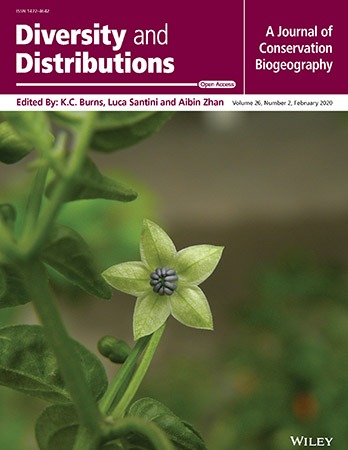
Biology Under Cover
Selected Journal & Book Covers from SBS Faculty
"Modelled distributions and conservation status of the wild relatives of chile peppers"
Lynn Bohs
Summary
Wild plants evolve to survive the whims of nature and thrive in difficult conditions, including extreme climate conditions, poor soils, and pests and disease. It makes them tougher than their better-known descendants—the domesticated plants that are critical to a healthy diet who are not nearly as hardy. The genes that make crop wild relatives robust have the potential to make their cultivated cousins – our food plants - better prepared for a harsh climate future. But a series of new research papers show these critical plants are imperiled. Certain chile peppers, says SBS’s botanist Lynn Bohs- external site, who with Khoury and others recently published new findings on the subject, have found themselves in one such imperiled grouping: “It is important to know the conservation status of the wild Capsicum species in order to prioritize regions for further collecting or habitat preservation so that these genetic resources are available for future crop improvement.”
Aim
To fill critical knowledge gaps with regard to the distributions and conservation status of the wild relatives of chile peppers (Capsicum L.). Location: The study covered the potential native ranges of currently recognized wild Capsicum taxa, throughout the Americas. Methods: We modelled the potential distributions of 37 wild taxa in the genus, characterized their ecogeographic niches, assessed their ex situ and in situ conservation status, and performed preliminary threat assessments. Results: We categorize 18 of the taxa as “high priority” for further conservation action as a consequence of a combination of their ex situ and in situ assessments, 17 as “medium priority,” and two as “low priority.” Priorities for resolving gaps in ex situ conservation were determined to be high for 94.6%, and medium or high with regard to increased habitat protection for 64.9% of the taxa. The preliminary threat assessment indicated that six taxa may be critically endangered, three endangered, ten vulnerable, six near threatened and 12 least concern. Main Conclusions: Taxonomic richness hot spots, especially along the Atlantic coast of Brazil, in Bolivia and Paraguay, and in the highlands of Colombia, Ecuador, Peru and Venezuela, represent particularly high priority regions for further collecting for ex situ conservation as well as for enhanced habitat conservation.
